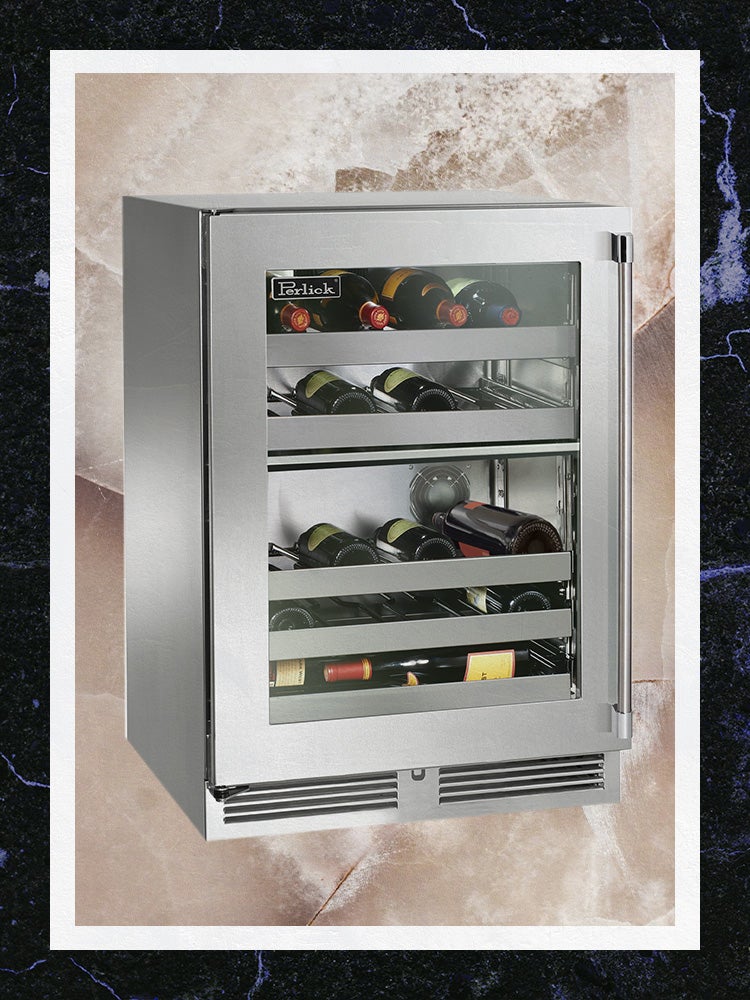Here’s Why the Best Dual-Zone Wine Fridges Are a Bottle’s Best Friend
Psst: They’re perfect for entertaining and leisurely pours.
Updated Jun 3, 2022 3:45 AM
We may earn revenue from the products available on this page and participate in affiliate programs.
Reading up on Domino’s shopping guides is like having your own personal product concierge. We do the tedious part—deep-dive research, hands-on testing, and tapping experts for advice—so all you have to do is hit “add to cart.” That’s why we call them Simply the Best.
Buying a wine fridge is one of those aspirational investments that feels like a luxury (at first). But once one has made its way into your home and become part of dining rituals, let’s just call it a life necessity. In the case of the best dual-zone wine fridges, which include coolers that allow for two separate temperatures in the same unit, it’s all about flexibility—keeping your whites cool and ready to drink at a moment’s notice while safely storing other bottles at cellar temps. It’s also a lifesaver for entertaining. “A dual-zone wine fridge is wonderful for when you want to pair red and white wines with the food you’re serving,” Madame de la Maison founder Ajiri Aki notes.
Whether you are a bona fide oenophile or an aspiring wine collector, or you simply feel guilty for sticking your Sauvignon Blanc in the freezer to cool it down quickly (it happens!), a dual-zone wine fridge is a smart solution for wine drinkers of all degrees. Ahead, get our picks based on advice from wine and entertaining industry insiders and firsthand testing by Domino editors.
Our Favorites
- Best overall: Hisense Stainless Steel Wine Cooler
- Best value: Frigidaire Wine Cooler
- Best built-in: KitchenAid Undercounter Wine Cooler
- Best outdoor: Perlick Signature Series Wine Reserve
- Best small space: Smith & Hanks Wine Fridge
- Best panel ready: Zephyr Presrv Dual Zone Wine Cooler
- Best upgrade pick: Eurocave Pure-Professional Wine Cellar
Best Overall: Hisense Stainless Steel Wine Cooler

Size: 23-by-24-by-26 inches | Temp minimum: 41°F | Shelf style: Slide out | Bottles: 46 | Installation: Freestanding or built-in
What we like:
- Generous bottle capacity
- Temperature consistency
- Top rack can accommodate larger bottles
Worth noting:
- Spacing can be awkward if bottle shapes vary
Why we chose it: This wine fridge looks sharp, works efficiently, and holds almost 50 bottles while costing less than comparable models of the same capacity.
Within minutes of installing Hisense’s ultra-quiet dual-zone wine cooler (one of the models we tested out), it was clear this stainless steel beauty had to top our list. It hits all the marks in terms of design details, beginning with a frost-free glass door that’s UV protected and low-E (a term for low emissivity, meaning it reflects heat away from the bottles, making it more efficient—three cheers for lower energy bills!). There are five soft-close wood-front shelves that keep bottle vibrating (a big no-no for wine storage) to a minimum, and the top shelf has more clearance, which is perfect for sparkling wine or oddly shaped bottles.
We especially liked that it comes with a reversible door option so you can place the handle on either side, as well as an open-door alarm. This model can be built in or freestanding, lending versatility, and it comes with a two-year parts and five-year compressor warranty. As with all wine fridges, we noticed that when laying bottles of varying sizes next to each other, it impacted the amount that could be stored on that particular shelf—so keep in mind that depending on your bottle shapes and sizes, you might not fit the full 48 capacity.
Best Value: Frigidaire Stainless Steel Bottle Wine Cooler
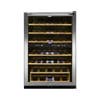
Size: 21.5-by-33.9-by-22.3 inches | Temp minimum: 41°F | Shelf style: Slide out | Bottles: 38 | Installation: Freestanding
What we like:
- Strong temperature consistency
- Size is good for beginners or those with smaller spaces
- Good value
Worth noting:
- Not a ton of storage for oddly shaped bottles
- More affordable than most dual-zone fridges
Why we chose it: A high-value pick for burgeoning wine collectors or city dwellers.
If you’re new to the wine-collecting game or have limited space in your home, Hispanics in Wine cofounder Lydia Richards points to Frigidaire’s 38-bottle cooler as the winning pick. “I love the quality, storage capacity, and temperature consistency of this fridge,” she says. Other design highlights she notes include the frost-free feature and tinted glass door with UV protection: “It’s a long-lasting fridge that looks good and offers great value.”
The two zones range between 41 and 64 degrees, and the fan-forced cooling helps to keep temperatures consistent. There are five slide-out natural wood racks and a stainless steel door, all simple and polished. Some reviewers noted they had difficulty fitting their oddly shaped bottles, so if you have a particularly large amount of, say, champagne that you need to store, you’ll probably end up with fewer bottles than full capacity.
Best Built-In: KitchenAid Undercounter Wine Cooler
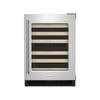
Size: 24-by-34-by-23 inches | Temp minimum: 42°F | Shelf style: Slide out | Bottles: 46 | Installation: Built-in
What we like:
- Flush installation with hidden hinges
- Over-temperature alarm
- Sabbath mode option
Worth noting:
- Not cheap
Why we chose it: While it will put a dent in your wallet, this built-in fridge is timeless and has all the features you’ll need to safely store your wine.
For a wine fridge that pulls out all the stops, La Cura founder Olivia Muniak says to go with KitchenAid. “It is the trusted powerhouse for appliances in my home,” she shares. “Opt for the sleek stainless steel design or choose to customize to match the cabinetry in your kitchen.” The brand’s dual-zone model allows for 46 bottles; built-in flush installation with hidden hinges and a standard 24-inch base keeps it from poking out from a row of cabinetry.
Odd sizes, you’re welcome here: There’s room for eight Bordeaux-style bottles on each of the five upper racks and six champagne-style bottles on the lower rack. If things are on the fritz, it won’t go unnoticed—the temperature-monitoring system detects if your fridge goes above 70 degrees for more than four hours and alerts you with an alarm and indicator light. Other fun features include motion-activated LED lighting so you can see what’s inside without opening the door, and if you do accidentally leave it open, an alarm will go off after five minutes (it stops once you close the door or touch the controls). Also worth noting is Sabbath mode, which disables automatic lights and alarm tones to meet kosher requirements for use on the Jewish Sabbath and other religious holidays.
Best Outdoor: Perlick Signature Series Outdoor Wine Reserve
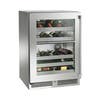
Size: 24-by-34-by-24 inches | Temp minimum: 33°F | Shelf style: Slide out | Bottles: 32 | Installation: Freestanding or built-in
What we like:
- Eco-friendly and energy efficient
- Can be customized
- UL rated for outdoor use
- Extended warranty available
Worth noting:
- Expensive
Why we chose it: This professional-grade pick comes with a several-year warranty and is rated for outdoor use. The main drawback? A hefty price tag.
We tapped Denise Thornberry, the owner and founder of Tasting House (a new tasting bar in Los Gatos, California), to give us the scoop on how she keeps all of her bottles safely stored, and Perlick was her hands down pick. “It’s eco-friendly, quiet, and energy efficient,” she shares. “I love the easy-access, smooth-glide shelving. Also you can customize the design—black or stainless, wood or metal shelving, white or blue lighting.”
The brand also offers outdoor models for alfresco sippers. It can withstand the elements thanks to the mix of 300 series steel, which is corrosion resistant while also being safe for food and beverages. If you live near the ocean, its Marine & Coastal series offers protection against high salt and chemical environments and is designed with upgraded fasteners to safeguard against windy conditions.
Best Small Space: Smith & Hanks Wine Fridge
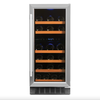
Size: 15-by-34-by-23 inches | Temp minimum: 31°F | Shelf style: Slide out | Bottles: 32 | Installation: Freestanding or built-in
What we like:
- Convenient size, especially for dual zone
- Won’t know it’s there (re: noise)
- Built in or freestanding
Worth noting:
- Smaller bottle capacity
Why we chose it: A dual-zone wine fridge that’s ideal for small apartments but doesn’t skimp on quality or design.
Anyone who has lived in New York City knows that space is sacred, which is why locating a wine fridge that doesn’t compromise precious square footage is a real challenge. For freelance wine and spirits writer Céline Bossart, the solution is simple: Go for a narrow model. “As a wine professional in a New York City apartment, I always appreciate a wine fridge that’s both multi-zone and compact,” she says. Her Smith & Hanks pick is only 15 inches wide but highly efficient in terms of size and power. “It’s also very quiet. Nobody likes a loud appliance, especially in smaller spaces,” she adds.
Despite being slim, this pick can fit 32 bottles and comes in a stainless steel finish with six wood-accented shelves. The glass is double paneled and designed with a UV shield, and the unit can be used as a freestanding model or a built-in. “In general, I think it’s a good idea to invest in a built-in wine fridge as opposed to just freestanding, as it’s always nice to have the option to incorporate it into cabinetry somewhere down the line, even if you’re not planning to right away,” Bossart suggests.
Best Panel Ready: Zephyr Presrv Dual Zone Wine Cooler
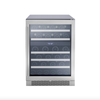
Size: 24-by-34-by-24 inches | Temp minimum: 40°F | Shelf style: Slide out | Bottles: 45 | Installation: Freestanding or built-in
What we like:
- Reversible door
- Whisper quiet
- Shelves at different heights to accommodate different size bottles
- ADA-compliant option
Worth noting:
- Sizable for a freestanding fridge
- Bottom shelf doesn’t slide out
Why we chose it: A roomy dual-zone wine fridge that looks just as good freestanding as it does customized to your cabinetry.
If you, like Domino’s deputy commerce editor, Samantha Weiss-Hills, regularly host with wine or love to stock up on bottles from your travels, Zephyr’s wine coolers should be on your radar. Its dual-zone fridge comes in several variations: original, French door, full size, panel ready, pro, and ADA compliant. The original’s sleek stainless steel reversible door is finished with dual-pane glass that stays superclear when closed, allowing you to easily peek inside at your inventory. It fits up to 45 bottles, but that number probably depends on what you tend to drink—Pinot Noir bottles are bulkier than those of Riesling. (To note: The bottom shelf that stores six bottles is stationary.)
Chic stainless steel–fronted, wood-slat shelves glide in and out smoothly so you don’t have to worry about anything wiggling around, and each zone has two different shelf heights. The temperature panel is easy to control but not sensitive—it requires a bit of intention. And the lighting has three different colors (we prefer the amber for its restaurant wine-cave vibes) and two different settings (automatic, which fades off when the door is closed, and active, which illuminates your collection continuously). This model, while it can be used freestanding, is just right for under a counter—even the ADA-compliant version, which can be adjusted below 32 inches. It would be ideal to build into a sizable entertaining kitchen or home bar, but it’s large for a small space at 2 feet wide and almost 3 feet high.
Best Upgrade: Eurocave Pure-Professional Wine Cellar
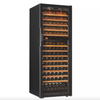
Size: 23-by-24-by-26 inches | Temp minimum: 41°F | Shelf style: Slide out | Bottles: 46 | Installation: Freestanding or built-in
What we like:
- Energy efficient
- Adjustable shelving system
- A wine industry favorite
Worth noting:
- The most expensive on our list
- Best for serious collectors
Why we chose it: This professional pick has everything you’ll need to create an at-home cellar—but it’ll cost you a pretty penny (and storage space).
If you ask Fermented Grapes founder Kilolo Strobert what makes her heart sing, it’s exactly what you’d expect from the wine shop owner and industry veteran. “I’d like to say that I think refrigeration is exciting,” she says, laughing. “I’m sure that sounds odd coming from an oenophile and sommelier, but I believe it’s par for the course. Protection of our product is super high up on the list of priorities, and as a wine store owner it is mine.” The wine fridge she stands by is EuroCave, a brand manufactured in France that has been around since the ’70s. “Yes, they are the most expensive, but they are the best built,” she says.
So what makes this pick so outstanding? Aside from the impressive volume capacity and dual-zone temperature control, it has impeccable efficiency (55 percent more efficient than its previous models) and recently revamped shelf spacing to allow all 750-milliliter bottles to fit comfortably. The slide-out shelves feature 12 adjustable “hands” that cradle each bottle securely with rubber insets (in other words, no rattling or clinking together when sliding the shelf in or out). EuroCave is a top-notch pick, and if you’re ready to take your wine collection to the next level, you can’t go wrong with its dual-zone model. However, if you simply need a place to store a few of your beloved bottles, this will probably be too large and expensive than what’s necessary.
How We Chose These Products
In addition to testing out a few models ourselves, we tapped experts in the wine and entertaining industries for their insights regarding not only their favorite dual-zone fridges, but what design details to look out for. From there, we prioritized models that include protective features such as UV-tinted glass and temperature-increase alarms, and favored those that have thoughtful touches like adjustable shelving or a reversible door. Reliable temperature consistency and energy efficiency were also on the top of our list of requirements and—because a wine fridge is a prominent appliance in the home—they had to be crafted in quality, easy-on-the-eyes materials like stainless steel and natural wood.
Our Shopping Checklist
Size and Capacity
The size and bottle capacity of your dual-zone wine fridge will depend on the amount of space you have available in your home and how much of a collection you’d like to build. Unless you’re a die-hard collector, somewhere between 32 to 46 inches should do the trick. And if you’re especially limited on square footage, consider a fridge with a smaller width, like the 12-inch Smith & Hanks model highlighted earlier.
Cooling Tech
Wine coolers operate with either a thermoelectric or compressor system. Compressors tend to have more powerful cooling and are good at maintaining stable temperatures. The downside to a compressor is the chance of a slight vibration or noise, though how much or how little depends on the model. Thermoelectric systems, on the other hand, are quieter and vibration free, but they’re considered to have weaker cooling than their compressor counterparts. Most of the models we highlight use compressors that incorporate technology to help offset any noise or vibrations, such as a variable speed compressor, to minimize sound.
Shelving
While some wine fridges are designed with scalloped shelving to hold bottles, we found that the slide-out option was superior with regard to organization and leaving the bottles undisturbed. The models we tested offer wood-front or stainless steel–front shelving, while the EuroCave model goes above and beyond with its Main du Sommelier shelving, which features 12 adjustable “hands” that cradle the bottles individually.
Ask Domino
Q: I’m not really a white wine person. Should red wine be stored in a wine fridge?
“Wine wants to be kept in its optimal humidity and temperature range to help keep it stable no matter what color: red, white, rosé, or other,” Strobert says. So even if you don’t fancy yourself a white wine drinker, your red wine should still be stored at the cool, consistent temperature of around 55 degrees, away from the light and without any vibrations—unsurprisingly, a wine fridge makes this easier all year round. “Wines are delicate, living creatures, and when they’re improperly stored, their structure, delicacy, and overall flavor can be affected,” Muniak adds.
Q: What are the optimal temperatures in a wine fridge?
Generally speaking, white wines are best served between 43 and 55 degrees Fahrenheit, and red wines between 55 and 64 degrees. For storage, somewhere around 55 degrees (also known as “cellar temperature”) should work fine. But what about those days when you realize you want to serve a well-chilled Sauvignon Blanc with dinner? That’s where a dual-zone fridge hits its stride. The ability to keep the whites and sparkling section cooler than the cellar-temperature zone of the fridge is ideal for entertaining and eliminates any last-minute scrambles to rapidly cool down a bottle of wine (rarely a good idea).
Q: Does a wine cooler get as cold as a refrigerator?
Regular refrigerators are usually set around 40 degrees or below, while most dual-zone wine coolers have a minimum temperature that hovers around the 41- to 43-degree mark.
Q: Can you keep a wine fridge outside?
You sure can! However, it’s wise to buy a wine fridge that’s intended to be kept outdoors, as these models are designed with materials that are resistant to corrosion and environmental elements such as wind or salt in the air. Plus they’re able to withstand the wider temperature variation outdoors versus inside a home.
The Last Word
As Muniak puts it, “Upgrading your kitchen to include a dual-zone wine fridge is not only for serious collectors. Both wine enthusiasts and their friends will benefit from having perfectly stored and chilled wines at home.” Preserve the integrity of all your bottles while simultaneously not worrying about having a chilled white ready to be served on the fly. Now where’s the bar key?
